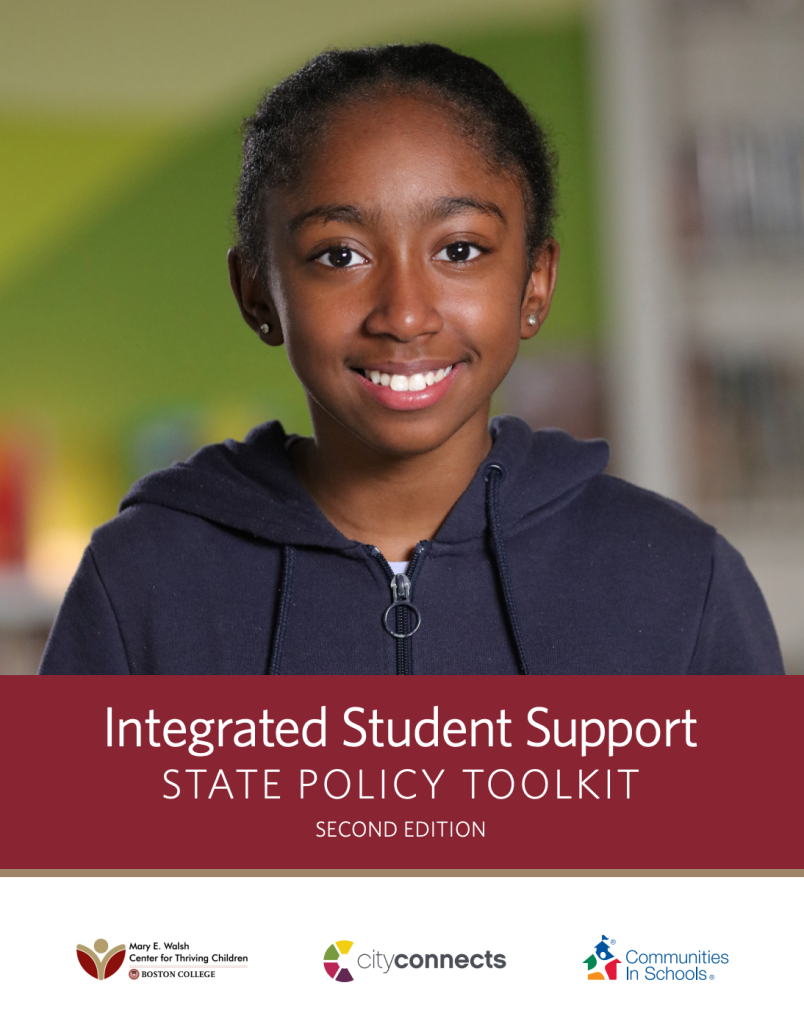Policymakers do the critical work of creating the context – the rules, budgets, and priorities – that schools and districts work within. To help policymakers use the latest insights from research and practice to encourage schools to build effective systems of student support, we’re releasing the second edition of our Integrated Student Support State Policy Toolkit.
The toolkit was created by the Mary E. Walsh Center for Thriving Children, part of Boston College’s Lynch School of Education and Human Development, as well as by City Connects, which is part of the Center, and by Communities in Schools, a national nonprofit organization that connects students to “caring adults and community resources.”
The updated toolkit draws on the principles of the National Guidelines for Integrated Student Support, which was released by the Center for Thriving Children. The National Guidlines were co-developed by a national working group of practitioners and researchers.
Because the toolkit reflects the latest policy trends, toolkit users can choose one of three different paths to implement systemic ways to support children. The paths are:
- Promoting best practices
- Scaling existing, evidence-based models, and
- A hybrid approach that combines promoting best practices and expanding current programs
The toolkit provides guidance on policy approaches and legislative language for all three approaches, and it shares specific steps that have been taken by a number of states.
Best Practices
Policymakers who want their schools to take a customized, home-grown approach to providing integrated student support will be interested in the promoting best practices path.
This approach has a number of key steps, including adopting a definition of integrated student support; establishing a framework to provide that support; and ensuring that the framework incorporates best practices such as serving every student and using data to monitor and inform the process.
One example of this approach is the Systemic Student Support (S3) Academy in Massachusetts. School and district teams enroll in the academy and, as the toolkit explains, “reimagine student support.” Drawing on the National Guidelines, the Academy “provides workshops, professional development, tailored coaching, and practical tools to help participants develop the capacity to review each individual students’ strengths and needs across multiple developmental domains.”
S3 Academy is run by The Rennie Center for Education Research and Policy, the Massachusetts Department of Elementary and Secondary Education, and the Boston College Center for Thriving Children.
Scaling Evidence Based Models
Instead of schools designing their own student support model, some policymakers may prefer to have schools implement a proven model.
The toolkit points to a number of states that have done this:
- Georgia “appropriated $1.4 million of state general funds in their FY22–23 budget to Communities In Schools”
- Minnesota “dedicated $5 million in FY24–25 to allow 18 geographically distributed schools to implement the BARR model over three years”
- Ohio “has named City Connects and Communities In Schools as allowable uses of its Student Wellness and Success Funds,”
- Texas “allocated funds in FY21–23 from both general revenue and TANF for Communities In Schools that highlight integrated student supports and seek to increase students’ and families’ interests, passions, and relationships in the service of promoting equitable learning conditions both inside and outside of school,”
- West Virginia “committed $4.9 million in FY23 for Communities In Schools,” and
- In Indiana, Marian University became home to the City Connects Midwest Technical Assistance Center, which supports the implementation of City Connects in schools across the state
A hybrid approach
The toolkit’s hybrid approach creates more choice in a given location. Some schools and districts can use best practices to design their own model of integrated student support. Other schools and districts can choose to implement an existing model.
One example is Minnesota, which is working with the BARR Center. BARR will enable the state to take the best practices path by helping to design “a statewide multi-tiered student support framework.”
Schools can instead choose to take the scaling an evidence-based model path by implementing BARR’s existing system of integrated student support, which relies on “data and relationships” to improve education.
A common goal
No matter what path policymakers and educators choose, they can use the toolkit to achieve the common goal of understanding and addressing students’ needs.
As the toolkit itself concludes, “In your hands, this Toolkit can help to create the conditions for all children to receive the integrated student support and opportunities they need to learn and thrive.”

